Abstract
The pharmacokinetics of aztreonam in eight adult patients with severe burn injuries (total body surface area burn, 49% +/- 21% [mean +/- standard deviation]) were studied. The time of initiation of study following burn injury was 7.0 +/- 1.4 days. Four patients at first dose and at steady state were studied. Aztreonam concentrations were measured by high-performance liquid chromatography, and a two-compartment model was used to fit the data. No significant differences in any pharmacokinetic parameters between first dose and steady state were observed. Volume of distribution of the central compartment after first dose (0.14 liters/kg) and volume of distribution at steady state (0.31 liters/kg) were approximately 30% higher than those reported for other patient populations. Total drug clearance and renal drug clearance when normalized to creatinine clearance (CLCR) were similar to those previously reported for other critically ill patients. CLCR was strongly correlated with renal drug clearance (r = 0.94) and total drug clearance (r = 0.95). The extent and degree of burn (percent second or third degree burn) were poorly correlated with all pharmacokinetic parameters with the exception of the volume of distribution at steady state, which was correlated with both total body surface area burn (r = 0.95) and percent second degree burn (r = 0.83). Aztreonam pharmacokinetics are altered as a result of thermal injury; however, CLCR can be used to assess the clearance of aztreonam in burn patients.
Full text
PDF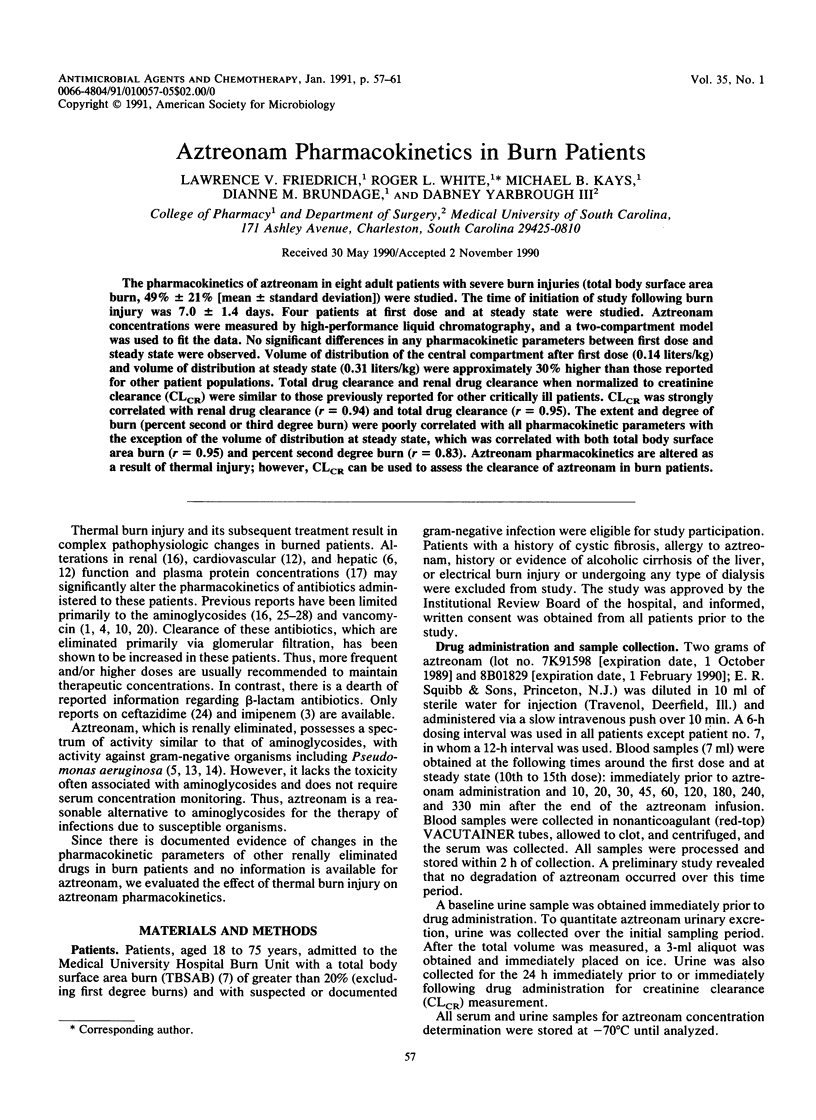
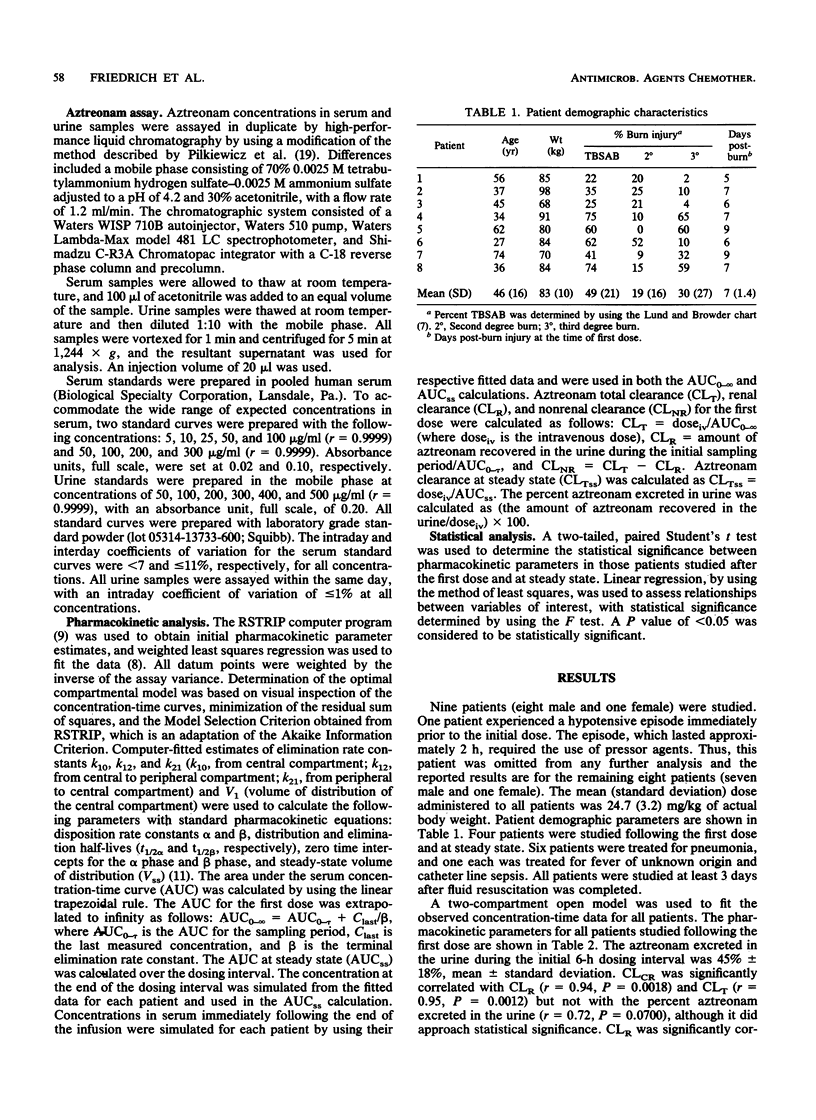
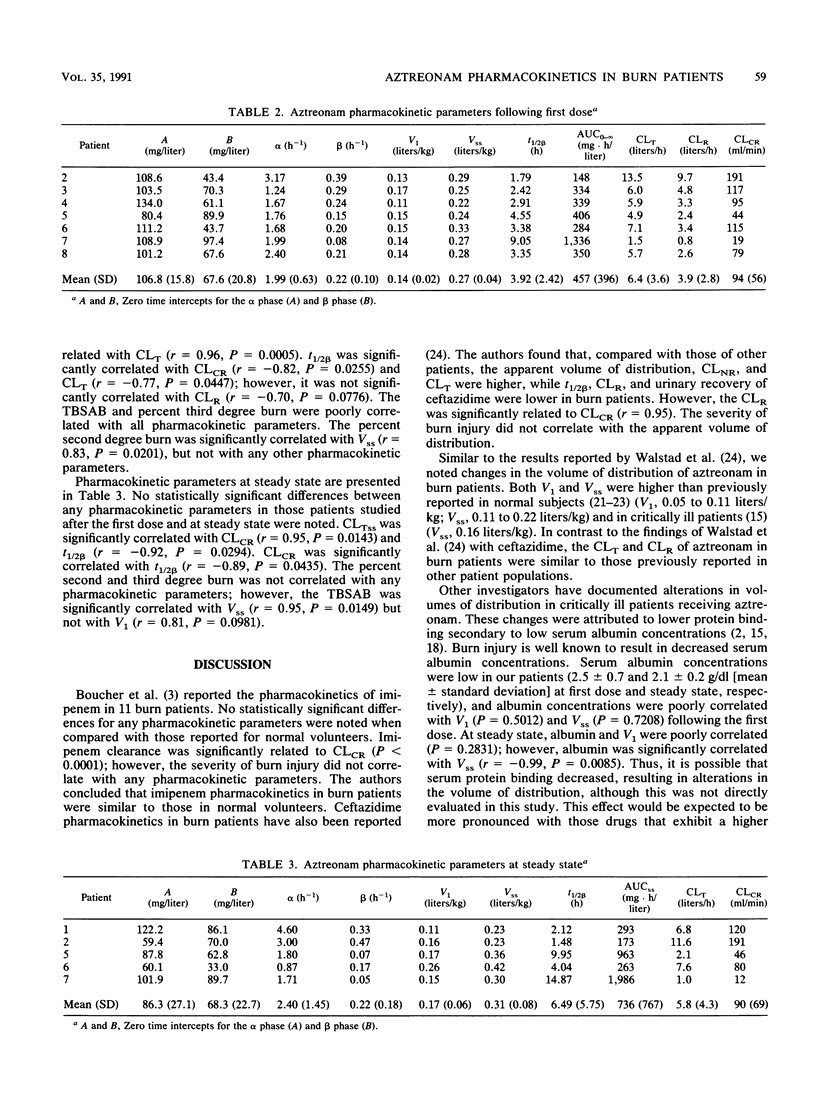
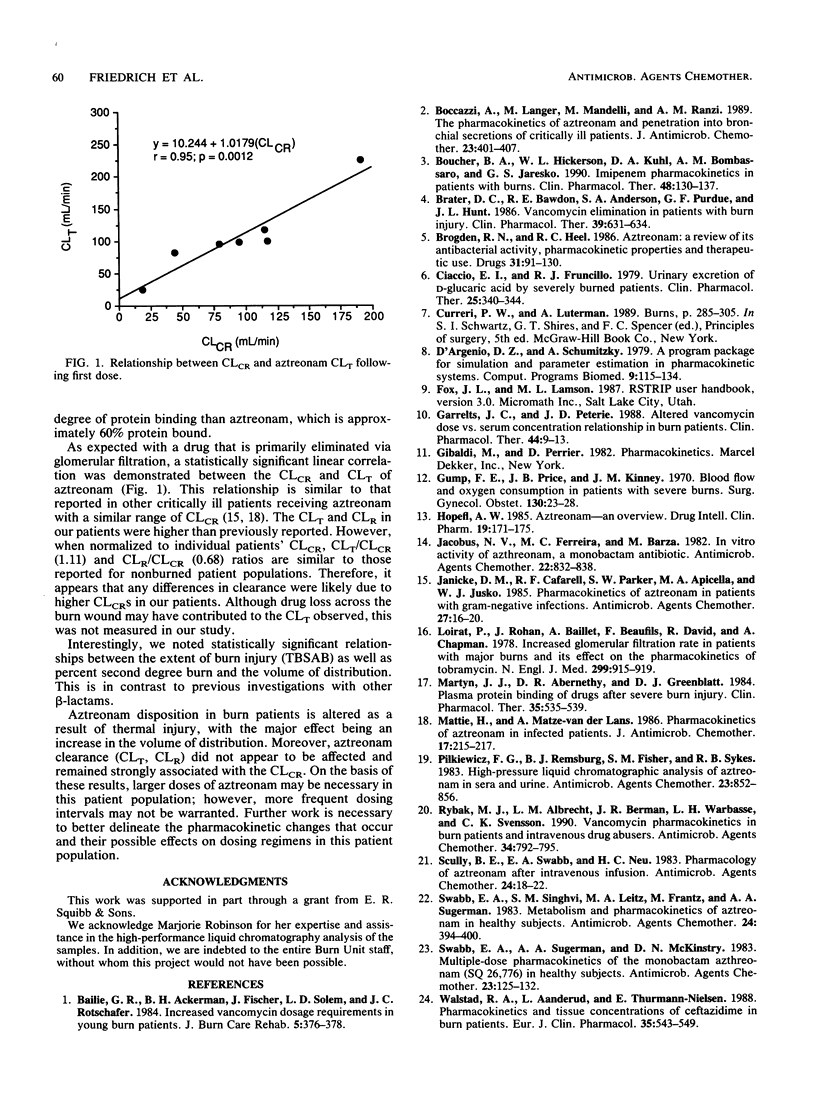
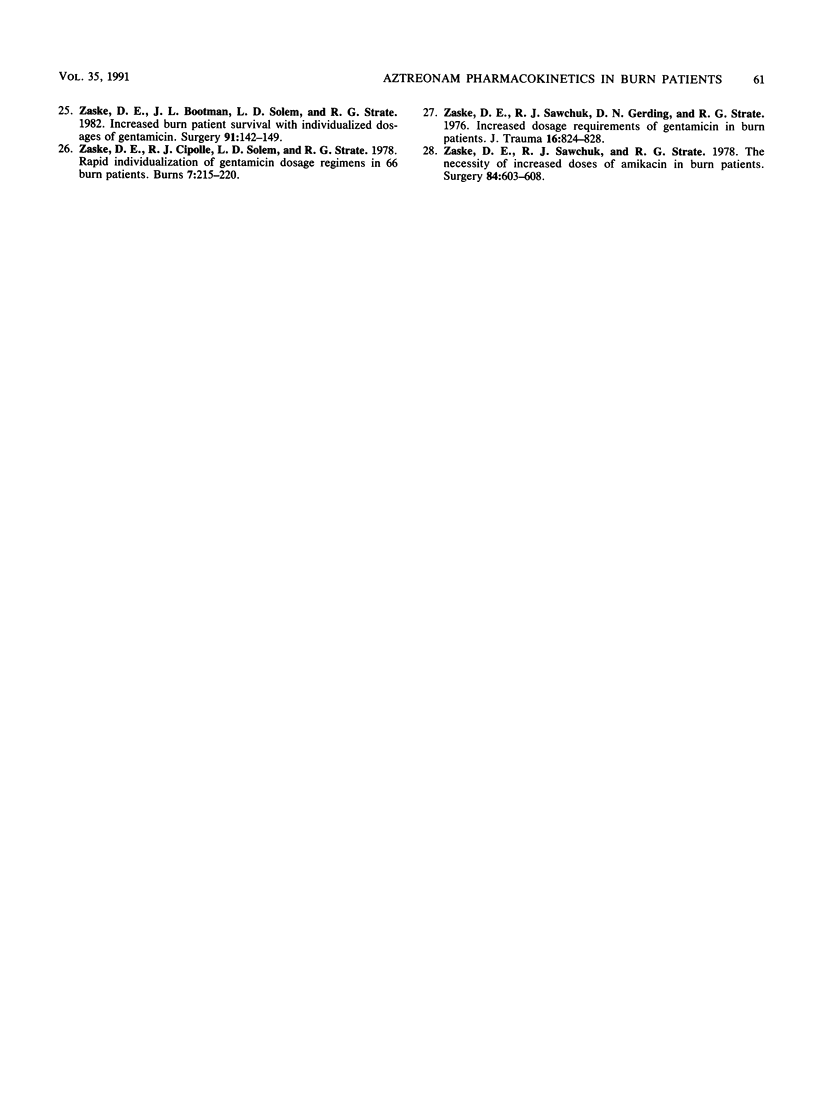
Selected References
These references are in PubMed. This may not be the complete list of references from this article.
- Boccazzi A., Langer M., Mandelli M., Ranzi A. M., Urso R. The pharmacokinetics of aztreonam and penetration into the bronchial secretions of critically ill patients. J Antimicrob Chemother. 1989 Mar;23(3):401–407. doi: 10.1093/jac/23.3.401. [DOI] [PubMed] [Google Scholar]
- Boucher B. A., Hickerson W. L., Kuhl D. A., Bombassaro A. M., Jaresko G. S. Imipenem pharmacokinetics in patients with burns. Clin Pharmacol Ther. 1990 Aug;48(2):130–137. doi: 10.1038/clpt.1990.127. [DOI] [PubMed] [Google Scholar]
- Brater D. C., Bawdon R. E., Anderson S. A., Purdue G. F., Hunt J. L. Vancomycin elimination in patients with burn injury. Clin Pharmacol Ther. 1986 Jun;39(6):631–634. doi: 10.1038/clpt.1986.111. [DOI] [PubMed] [Google Scholar]
- Brogden R. N., Heel R. C. Aztreonam. A review of its antibacterial activity, pharmacokinetic properties and therapeutic use. Drugs. 1986 Feb;31(2):96–130. doi: 10.2165/00003495-198631020-00002. [DOI] [PubMed] [Google Scholar]
- Ciaccio E. I., Fruncillo R. J. Urinary excretion of D-glucaric acid by severely burned patients. Clin Pharmacol Ther. 1979 Mar;25(3):340–344. doi: 10.1002/cpt1979253340. [DOI] [PubMed] [Google Scholar]
- D'Argenio D. Z., Schumitzky A. A program package for simulation and parameter estimation in pharmacokinetic systems. Comput Programs Biomed. 1979 Mar;9(2):115–134. doi: 10.1016/0010-468x(79)90025-4. [DOI] [PubMed] [Google Scholar]
- Garrelts J. C., Peterie J. D. Altered vancomycin dose vs. serum concentration relationship in burn patients. Clin Pharmacol Ther. 1988 Jul;44(1):9–13. doi: 10.1038/clpt.1988.105. [DOI] [PubMed] [Google Scholar]
- Gump F. E., Price J. B., Jr, Kinney J. M. Blood flow and oxygen consumption in patients with severe burns. Surg Gynecol Obstet. 1970 Jan;130(1):23–28. [PubMed] [Google Scholar]
- Hopefl A. W. Aztreonam--an overview. Drug Intell Clin Pharm. 1985 Mar;19(3):171–175. [PubMed] [Google Scholar]
- Jacobus N. V., Ferreira M. C., Barza M. In vitro activity of azthreonam, a monobactam antibiotic. Antimicrob Agents Chemother. 1982 Nov;22(5):832–838. doi: 10.1128/aac.22.5.832. [DOI] [PMC free article] [PubMed] [Google Scholar]
- Janicke D. M., Cafarell R. F., Parker S. W., Apicella M. A., Jusko W. J. Pharmacokinetics of aztreonam in patients with gram-negative infections. Antimicrob Agents Chemother. 1985 Jan;27(1):16–20. doi: 10.1128/aac.27.1.16. [DOI] [PMC free article] [PubMed] [Google Scholar]
- Loirat P., Rohan J., Baillet A., Beaufils F., David R., Chapman A. Increased glomerular filtration rate in patients with major burns and its effect on the pharmacokinetics of tobramycin. N Engl J Med. 1978 Oct 26;299(17):915–919. doi: 10.1056/NEJM197810262991703. [DOI] [PubMed] [Google Scholar]
- Martyn J. A., Abernethy D. R., Greenblatt D. J. Plasma protein binding of drugs after severe burn injury. Clin Pharmacol Ther. 1984 Apr;35(4):535–539. doi: 10.1038/clpt.1984.73. [DOI] [PubMed] [Google Scholar]
- Mattie H., Matze-van der Lans A. Pharmacokinetics of aztreonam in infected patients. J Antimicrob Chemother. 1986 Feb;17(2):215–219. doi: 10.1093/jac/17.2.215. [DOI] [PubMed] [Google Scholar]
- Pilkiewicz F. G., Remsburg B. J., Fisher S. M., Sykes R. B. High-pressure liquid chromatographic analysis of aztreonam in sera and urine. Antimicrob Agents Chemother. 1983 Jun;23(6):852–856. doi: 10.1128/aac.23.6.852. [DOI] [PMC free article] [PubMed] [Google Scholar]
- Rybak M. J., Albrecht L. M., Berman J. R., Warbasse L. H., Svensson C. K. Vancomycin pharmacokinetics in burn patients and intravenous drug abusers. Antimicrob Agents Chemother. 1990 May;34(5):792–795. doi: 10.1128/aac.34.5.792. [DOI] [PMC free article] [PubMed] [Google Scholar]
- Scully B. E., Swabb E. A., Neu H. C. Pharmacology of aztreonam after intravenous infusion. Antimicrob Agents Chemother. 1983 Jul;24(1):18–22. doi: 10.1128/aac.24.1.18. [DOI] [PMC free article] [PubMed] [Google Scholar]
- Swabb E. A., Singhvi S. M., Leitz M. A., Frantz M., Sugerman A. Metabolism and pharmacokinetics of aztreonam in healthy subjects. Antimicrob Agents Chemother. 1983 Sep;24(3):394–400. doi: 10.1128/aac.24.3.394. [DOI] [PMC free article] [PubMed] [Google Scholar]
- Swabb E. A., Sugerman A. A., McKinstry D. N. Multiple-dose pharmacokinetics of the monobactam azthreonam (SQ 26,776) in healthy subjects. Antimicrob Agents Chemother. 1983 Jan;23(1):125–132. doi: 10.1128/aac.23.1.125. [DOI] [PMC free article] [PubMed] [Google Scholar]
- Walstad R. A., Aanderud L., Thurmann-Nielsen E. Pharmacokinetics and tissue concentrations of ceftazidime in burn patients. Eur J Clin Pharmacol. 1988;35(5):543–549. doi: 10.1007/BF00558251. [DOI] [PubMed] [Google Scholar]
- Zaske D. E., Bootman J. L., Solem L. B., Strate R. G. Increased burn patient survival with individualized dosages of gentamicin. Surgery. 1982 Feb;91(2):142–149. [PubMed] [Google Scholar]
- Zaske D. E., Sawchuk R. J., Gerding D. N., Strate R. G. Increased dosage requirements of gentamicin in burn patients. J Trauma. 1976 Oct;16(10):824–828. doi: 10.1097/00005373-197610000-00014. [DOI] [PubMed] [Google Scholar]
- Zaske D. E., Sawchuk R. J., Strate R. G. The necessity of increased doses of amikacin in burn patients. Surgery. 1978 Nov;84(5):603–608. [PubMed] [Google Scholar]


